
Silphium is a genus of North American plants in the tribe Heliantheae within the family Asteraceae.
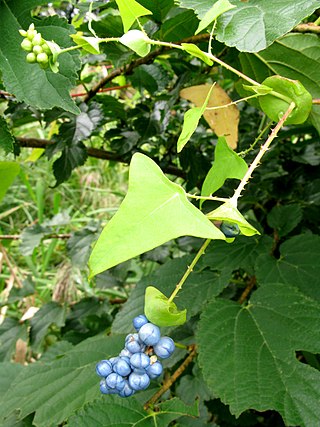
Persicaria perfoliata is a species of flowering plant in the buckwheat family. Common names include mile-a-minute, devil's tail, giant climbing tearthumb, and Asiatic tearthumb. It is a trailing herbaceous annual vine with barbed stems and triangular leaves. It is native to most of temperate and tropical eastern Asia, occurring from eastern Russia and Japan in the north, and the range extending to the Philippines and India in the south. P. perfoliata is an aggressive, highly invasive weed.

Eupatorium is a genus of flowering plants in the family Asteraceae, containing from 36 to 60 species depending on the classification system. Most are herbaceous perennials growing to 0.5–3 m (1.6–9.8 ft) tall. A few are shrubs. The genus is native to temperate regions of the Northern Hemisphere. Most are commonly called bonesets, thoroughworts or snakeroots in North America. The genus is named for Mithridates Eupator, king of Pontus.
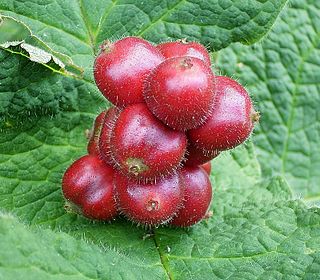
Triosteum, commonly known in American English as horse-gentian or, less commonly, feverwort, and, in Standard Chinese as 莛子藨属, is a genus of flowering plants belonging to the family Caprifoliaceae. A genus of six species in total, it has three species native to North America, and three more in eastern Asia.
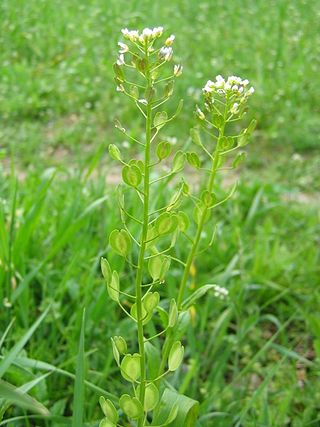
Thlaspi, or pennycress, is a genus of herbs of temperate regions of the Eurasian continent. They occur in Central and South Europe, South-West Asia and two species are endemic to China. The Thlaspi has been proven to be a hyperaccumulator of heavy metals such as zinc and cadmium and therefore may be used in phytoremediation initiatives.
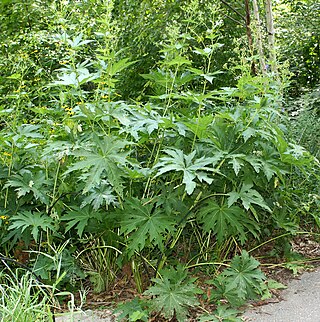
Napaea is a monotypic genus of flowering plants in the mallow family Malvaceae. The single species is Napaea dioica, a tall perennial herbaceous plant, native to central and eastern USA. Plants are occasionally grown as ornamentals in wildflower gardens. A common name is glade mallow.

Eupatorium perfoliatum, known as common boneset or just boneset, is a North American perennial plant in the family Asteraceae. It is a common native to the Eastern United States and Canada, widespread from Nova Scotia to Florida, west as far as Texas, Nebraska, the Dakotas, and Manitoba. It is also called agueweed, feverwort, or sweating-plant. It was introduced to American colonists by natives who used the plant for breaking fevers by means of heavy sweating. It is nearly always found in low, wet areas.

Azolla cristata , the Carolina mosquitofern, Carolina azolla or water velvet, is a species of Azolla native to the Americas, in eastern North America from southern Ontario southward, and from the east coast west to Wisconsin and Texas, and in the Caribbean, and in Central and South America from southeastern Mexico (Chiapas) south to northern Argentina and Uruguay.

Monarda fistulosa, the wild bergamot or bee balm, is a wildflower in the mint family Lamiaceae, widespread and abundant as a native plant in much of North America. This plant, with showy summer-blooming pink to lavender flowers, is often used as a honey plant, medicinal plant, and garden ornamental. The species is quite variable, and several subspecies or varieties have been recognized within it.

The Great Balsam Mountains, or Balsam Mountains, are in the mountain region of western North Carolina, United States. The Great Balsams are a subrange of the Blue Ridge Mountains, which in turn are a part of the Appalachian Mountains. The most famous peak in the Great Balsam range is Cold Mountain, which is the centerpiece of author Charles Frazier's bestselling novel Cold Mountain.

Lepidium perfoliatum is a species of flowering plant in the mustard family known by the common names clasping pepperweed and perfoliate pepperwort. It is native to Europe and Asia and it can be found in other parts of the world as an introduced species.
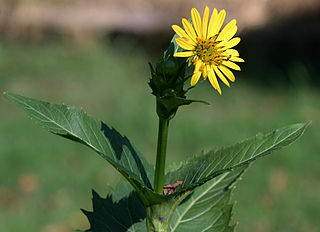
Silphium perfoliatum, the cup plant or cup-plant, is a species of flowering plant in the family Asteraceae, native to eastern and central North America. It is an erect herbaceous perennial with triangular toothed leaves, and daisy-like yellow composite flower heads in summer.

Thelypteris palustris, the marsh fern, or eastern marsh fern, is a species of fern native to eastern North America and across Eurasia. It prefers to grow in marshy situations in full sun. The species epithet palustris is Latin for "of the marsh" and indicates its common habitat. It is the only known host plant for Fagitana littera, the marsh fern moth.

Solidago speciosa, the showy goldenrod, is a North American species of flowering plants in the family Asteraceae. It grows in the province of Ontario in central Canada, as well as in the eastern and central United States.

Woodsia obtusa, the bluntlobe cliff fern, is a common rock fern of Appalachia and eastern North America. It prefers a calcareous substrate, but also grows in neutral soils. It may grow on rock faces or in scree.

Triosteum angustifolium, commonly known as yellowfruit horse-gentian, is a species of flowering plant belonging to the family Caprifoliaceae. It is found Eastern North America, primarily in Limestone regions.
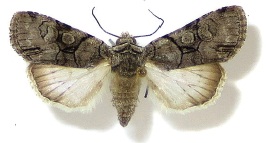
Sympistis forbesi is a moth of the family Noctuidae first described by Brigette Zacharczenko and David L. Wagner in 2014. It has been recorded from the US states of Iowa, Illinois and Minnesota and is believed to be extirpated from the eastern portion of the range in New York and New Jersey.

Silphium terebinthinaceum is a member of the Asteraceae, a family that includes sunflowers, and is commonly referred to as prairie dock or prairie rosinweed. It is native to central and eastern North America. "Rosinweed" became one of the plant's common names due to the fact that upon injury, resin flows from the wound, giving the plant a sweet smell. Tea brewed from the roots of the prairie dock have a variety of medical applications in Native American culture. The smoke from this plant has also been used as a treatment for congestion and rheumatism.

Triosteum aurantiacum, also known as orangefruit horse-gentian, is a perennial species of Triosteum native to North America.

Hypericum prolificum, known as shrubby St. John's wort, is a deciduous shrub in the genus Hypericum. It was named for its "prolific" number of stamens.





















